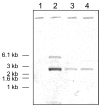The cell envelope subtilisin-like proteinase is a virulence determinant for Streptococcus suis
- PMID: 20146817
- PMCID: PMC2832634
- DOI: 10.1186/1471-2180-10-42
The cell envelope subtilisin-like proteinase is a virulence determinant for Streptococcus suis
Abstract
Background: Streptococcus suis is a major swine pathogen and zoonotic agent that mainly causes septicemia, meningitis, and endocarditis. It has recently been suggested that proteinases produced by S. suis (serotype 2) are potential virulence determinants. In the present study, we screened a S. suis mutant library created by the insertion of Tn917 transposon in order to isolate a mutant deficient in a cell surface proteinase. We characterized the gene and assessed the proteinase for its potential as a virulence factor.
Results: Two mutants (G6G and M3G) possessing a single Tn917 insertion were isolated. The affected gene coded for a protein (SSU0757) that shared a high degree of identity with Streptococccus thermophilus PrtS (95.9%) and, to a lesser extent, with Streptococcus agalactiae CspA (49.5%), which are cell surface serine proteinases. The SSU0757 protein had a calculated molecular mass of 169.6 kDa and contained the catalytic triad characteristic of subtilisin family proteinases: motif I (Asp200), motif II (His239), and motif III (Ser568). SSU0757 also had the Gram-positive cell wall anchoring motif (Leu-Pro-X-Thr-Gly) at the carboxy-terminus, which was followed by a hydrophobic domain. All the S. suis isolates tested, which belonged to different serotypes, possessed the gene encoding the SSU0757 protein. The two mutants devoid of subtilisin-like proteinase activity had longer generation times and were more susceptible to killing by whole blood than the wild-type parent strain P1/7. The virulence of the G6G and M3G mutants was compared to the wild-type strain in the CD1 mouse model. Significant differences in mortality rates were noted between the P1/7 group and the M3G and G6G groups (p < 0.001).
Conclusion: In summary, we identified a gene coding for a cell surface subtilisin-like serine proteinase that is widely distributed in S. suis. Evidences were brought for the involvement of this proteinase in S. suis virulence.
Figures





Similar articles
-
Identification of a cell wall-associated subtilisin-like serine protease involved in the pathogenesis of Streptococcus suis serotype 2.Microb Pathog. 2010 Mar-Apr;48(3-4):103-9. doi: 10.1016/j.micpath.2009.11.005. Epub 2009 Nov 26. Microb Pathog. 2010. PMID: 19944142
-
Purification and characterization of the subtilisin-like protease of Streptococcus suis that contributes to its virulence.Vet Microbiol. 2011 Mar 24;148(2-4):333-40. doi: 10.1016/j.vetmic.2010.09.024. Epub 2010 Oct 27. Vet Microbiol. 2011. PMID: 21030165
-
New putative virulence factors of Streptococcus suis involved in invasion of porcine brain microvascular endothelial cells.Microb Pathog. 2009 Jan;46(1):13-20. doi: 10.1016/j.micpath.2008.10.003. Epub 2008 Oct 17. Microb Pathog. 2009. PMID: 18984036
-
Virulence factors involved in the pathogenesis of the infection caused by the swine pathogen and zoonotic agent Streptococcus suis.Future Microbiol. 2012 Feb;7(2):259-79. doi: 10.2217/fmb.11.149. Future Microbiol. 2012. PMID: 22324994 Review.
-
Biological activities of suilysin: role in Streptococcus suis pathogenesis.Future Microbiol. 2016 Jul;11:941-54. doi: 10.2217/fmb-2016-0028. Epub 2016 Jun 30. Future Microbiol. 2016. PMID: 27357518 Review.
Cited by
-
Genome-Wide Analysis and Characterization of the Riemerella anatipestifer Putative T9SS Secretory Proteins with a Conserved C-Terminal Domain.J Bacteriol. 2022 Jul 19;204(7):e0007322. doi: 10.1128/jb.00073-22. Epub 2022 Jun 7. J Bacteriol. 2022. PMID: 35670588 Free PMC article.
-
hsdS, Belonging to the Type I Restriction-Modification System, Contributes to the Streptococcus suis Serotype 2 Survival Ability in Phagocytes.Front Microbiol. 2017 Aug 9;8:1524. doi: 10.3389/fmicb.2017.01524. eCollection 2017. Front Microbiol. 2017. PMID: 28848531 Free PMC article.
-
Isolation, Characterization and Biological Properties of Membrane Vesicles Produced by the Swine Pathogen Streptococcus suis.PLoS One. 2015 Jun 25;10(6):e0130528. doi: 10.1371/journal.pone.0130528. eCollection 2015. PLoS One. 2015. PMID: 26110524 Free PMC article.
-
Screening for Virulence-Related Genes via a Transposon Mutant Library of Streptococcus suis Serotype 2 Using a Galleria mellonella Larvae Infection Model.Microorganisms. 2022 Apr 21;10(5):868. doi: 10.3390/microorganisms10050868. Microorganisms. 2022. PMID: 35630313 Free PMC article.
-
Complete genome sequence of Streptococcus suis serotype 14 strain JS14.J Bacteriol. 2011 May;193(9):2375-6. doi: 10.1128/JB.00083-11. Epub 2011 Mar 11. J Bacteriol. 2011. PMID: 21398551 Free PMC article.
References
-
- Higgins R, Gottschalk M. In: Diseases of Swine. 9. Straw BE, D'Allaire S, Mengeling WL, Taylor DJ, editor. Iowa: Iowa University Press; 2005. Streptococcal Diseases; pp. 769–783.
Publication types
MeSH terms
Substances
LinkOut - more resources
Full Text Sources
Other Literature Sources

